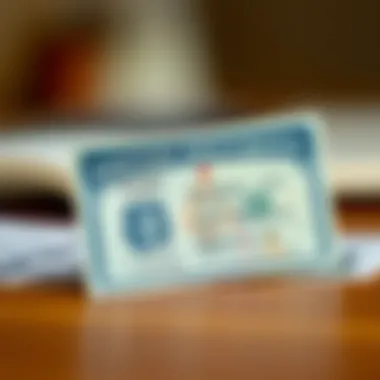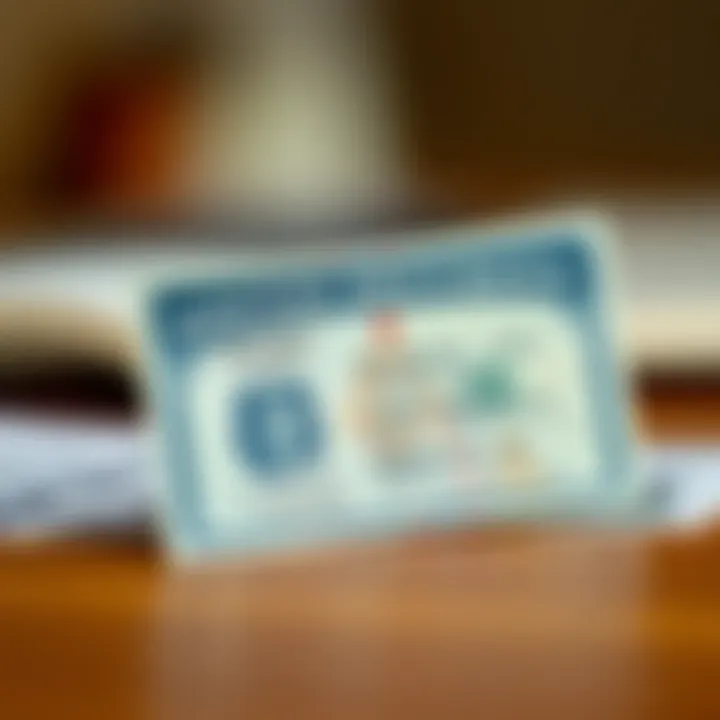How to Obtain a New Social Security Card After Marriage


Intro
Getting married is more than just a celebration of love; it also brings about various administrative tasks, one of which is updating your Social Security card. This process isn’t just a formality—it’s essential to ensure your new name aligns with government records, which can impact everything from tax filings to credit applications. Understanding the steps involved can save you time and prevent headaches in the future.
In this guide, we will delve into the nitty-gritty of obtaining a new Social Security card after marriage. You'll find comprehensive details about the application process, required documentation, and the potential implications of your name change on both legal and financial fronts.
Let’s jump in and explore how to navigate this administrative requirement efficiently while ensuring compliance with legal and financial protocols.
Understanding Personal Finances
After your wedding bells ring, it’s wise to sit down and reassess your personal finances. A new name and marital status may lead to changes in how you manage your money. Having a grasp on your finances ensures both partners are on the same page, reducing misunderstandings and fostering a healthy financial relationship.
Budgeting Techniques
Start with creating a joint budget if you've decided to share expenses. Make a list of all monthly income sources, including salaries and any side gigs. Then, note down regular expenses—think rent or mortgage, utilities, groceries, and debts. Spend time discussing your priorities as a couple.
- Account for wedding costs: If you overspend on the wedding, you may need to tighten the budget.
- Establish an emergency fund: Life can throw curveballs; a safety net is always a smart idea.
Tracking Expenses
Keep tabs on your spending with a mobile app or a spreadsheet. Regularly reviewing where your money goes helps in identifying any unnecessary expenditures. That morning coffee can add up over a month, so stay alert over time.
- Break expenses into categories like dining out, entertainment, and household needs.
- Review this monthly to watch for spending trends or changes.
Setting Financial Goals
Consider short-term and long-term financial goals. This can range from saving for a vacation to planning for children or a new home. As a couple, align your goals so you can work together to achieve them.
- Could you make a goal to save a specific amount each month?
- Talk about retirement planning early—it's easier to start saving when you're young.
Remember, open communication about finances can work wonders in any relationship.
To successfully manage finances as a newly married couple, it's essential to practice transparency and collaboration on budgeting decisions.
This initial overview sets the stage for understanding how obtaining a new Social Security card ties into your broader financial landscape. Let’s continue with the application process itself next.
Understanding the Importance of Your Social Security Card
Having a Social Security card might seem like a minor detail in the grand scheme of life. However, once you've tied the knot, updating or obtaining a new card becomes essential. This small piece of plastic holds significant weight. It plays a key role in various aspects of personal and financial identity, which can affect your life in many ways. But why exactly is it important? Here, we’ll unpack its role and why you shouldn’t overlook your Social Security card after marriage.
Role in Identity Verification
Your Social Security card acts as a cornerstone in confirming who you are. When you take on a new last name, potential employers, banks, and even government institutions will look to your Social Security card as a primary source for identity verification. This is not merely a trivial examination; the implications can stretch far beyond just a name change.
For instance, when you apply for jobs after your marriage, employers will require you to provide proof of identity that matches your application documents. If your name on the Social Security card doesn’t align with what’s on your resume or job application, it could lead to unnecessary complications. Sometimes, the smallest hiccup can delay or derail a job opportunity.
Impact on Financial Transactions
The significance of a Social Security card extends into the realm of finance as well. When it comes to opening bank accounts or applying for loans, a valid Social Security number is essential. Banks and lenders often rely on this information to access your credit history and verify your identity. If your name hasn’t been updated yet in the Social Security system, financial institutions may flag your application.
Moreover, your tax filings hinge on this card too. The Internal Revenue Service (IRS) requires accurate name and Social Security number information to process your tax returns. Failing to provide updated information could result in delays or even discrepancies in tax obligations. No one wants the IRS knocking on their door over a simple name change, right?
"Your Social Security card isn't just a card; it’s a key to the doors of your financial future."
In short, maintaining an up-to-date Social Security card is not just about compliance; it is an act of self-protection in a world where identity theft is rampant. Ignoring this task could lead to challenges that, while they might seem manageable now, could snowball into larger issues later on.
In the end, as you embark on this new chapter of your life, be sure to prioritize updating your Social Security card amidst the flurry of wedding plans and adjustments. Your future self will definitely thank you.
Marriage and Its Implications on Social Security Documents
Marriage brings about significant life changes, but it also triggers a necessary shift in your official documents, particularly your Social Security records. Such alterations are pivotal for maintaining accurate identity information and ensuring that your name aligns with your current marital status. Ignoring these updates could cause confusion or complications, particularly during financial transactions like applying for loans or managing your tax obligations.
Legal Name Changes
When you tie the knot, one of the most immediate changes you may consider is adopting a new surname, or perhaps combining both partners' names into a hyphenated version. This adjustment is more than just a personal preference; it carries legal weight. Changing your name officially can impact multiple facets of your life, ranging from banking to taxation.
To officially change your name with Social Security, you need to provide relevant documentation. Often, a marriage certificate suffices to prove the name change. Without this update, you open doors to potential miscommunication with employers, creditors, and even insurers. For instance, a mismatched name on your Social Security card compared to what’s on your tax returns could raise eyebrows during an audit.


But let’s not forget the mental gymnastics involved in this change. You’ll need to retrain yourself with your new name. That may mean updating social media profiles, email addresses, and, yes, even learning to respond to a different name in public.
Updating Personal Information
Updating your personal information extends beyond just name changes. You might have a new address to consider after marriage, or perhaps you have new beneficiaries to list on your accounts. All these changes require consideration and attention to detail to ensure they align with your Social Security records.
- Change of Address: If you’ve moved after the wedding, updating your address with Social Security is essential. This ensures that all correspondence reaches you without a hitch.
- Beneficiaries: Marriage often prompts individuals to rethink their beneficiaries, whether for insurance policies, retirement accounts, or even will provisions. You’ll want to ensure these updates reflect your current wishes to avoid disputes or complications down the road.
- Contact Information: Alongside your mailing address, updating your primary contact methods is also a good idea. This could include email or phone numbers, particularly if you’ve changed them post-ceremony.
In essence, ensuring all your personal information is up-to-date not only fosters accuracy but also avoids any future confusion.
"Keeping your records in sync could save you a lot of headaches later on. A stitch in time saves nine!"
By being proactive in these changes, you safeguard against potential legal and financial pitfalls down the road. It’s worth taking the time to ensure everything matches up, as these administrative tasks often set the groundwork for a smooth transition into married life.
The Process of Obtaining a New Social Security Card
Navigating the labyrinth of acquiring a new Social Security card post-marriage can seem like a Herculean task, yet it doesn't have to be. This process is essential, as it helps you update your personal details with the Social Security Administration (SSA). Having an accurate Social Security card ensures that your name aligns with your official documentation, which is crucial not only for identity verification but also for financial dealings. The stakes might seem low, but failing to update your information could lead to future headaches down the line.
Collecting Required Documentation
Getting ready for this process entails gathering a few crucial documents. Jumping into the fray without the proper ID can lead to unnecessary delays. Here’s a breakdown of what you'll need.
Proof of Identity
First and foremost, proving your identity is non-negotiable. Acceptable documents include a driver's license, passport, or state-issued ID. The key aspect of proof of identity is reliability; the SSA needs to verify that you are who you say you are. A driver’s license is often the most convenient option for many. One unique feature of this type of ID is that it usually contains your photo, residence, and physical descriptors, making it less likely to raise any additional questions.
However, it is vital to remember that any inconsistencies in the name or date of birth that don't match your marriage certificate can create a bottleneck in the process, so ensuring all documents are in alignment is a smart move.
Proof of Marriage
Proof of marriage is the next critical piece of the puzzle. A marriage certificate serves as the gold standard here. This document is crucial because it ties your old name to your new name legally. The beauty of a marriage certificate is its universal acceptance; it's straightforward and easy for the SSA to interpret.
The downside? If your marriage certificate is from a foreign country, it may need to be translated. This translation process can sometimes lag, elongating your timeline for obtaining that all-important card. But if you're using a U.S.-issued certificate, you're generally good to go.
Proof of Citizenship or Immigration Status
Last but not least, you must provide proof of citizenship or your immigration status. Acceptable documents include a U.S. passport, birth certificate, or immigration paperwork like a green card. The significance of this proof is crystal clear: it ensures that you're eligible for the benefits linked to your Social Security number.
A unique aspect of this type of documentation is that it can also serve as foundational proof for various applications you might encounter, like applying for jobs or loans. However, the drawback is that if you're a non-citizen, this could complicate things further as you might need additional paperwork based on your visa type—more hoops to jump through if you're not thoroughly prepared.
Filling Out the SS-5 Form
Once you've procured all necessary documents, the next task is filling out the SS-5 Form, the official application for a new Social Security card. This step may appear straightforward, but accuracy is paramount. Each box demands your undivided attention. Missing a detail or entering something incorrectly can create delays, resulting in a waiting game you’d rather avoid.
Submitting Your Application
The submission of your application is where things get interesting. You have a few avenues available to you for sending off your request, each with its pros and cons.
Online Submission Options
Submitting your application online can be a game-changer for simplicity. If you’re already registered with the SSA, you can quickly fill out your information. The key benefit here is convenience—you can do it from the comfort of your home. But not everyone may qualify for this method, as it typically requires you to have an established Social Security number and other identification on file.
Submitting by Mail
Mailing your application is another option. This method allows more flexibility in terms of when you can complete your application. However, the downside is that it lacks immediacy. You must allow for mail delivery times, which can be frustrating if you're hoping for a quick turnaround. Ensure you use a traceable mailing option to avoid any surprises.
In-Person Appointments
Lastly, there’s the in-person appointment route. This option is typically recommended for those who have questions or complex situations. It provides direct assistance from SSA personnel, which can be an invaluable resource. However, securing an appointment can be a hassle—think long wait times and scheduling conflicts.
In summary, navigating the maze of acquiring a new Social Security card requires diligence, but it's not insurmountable. Collecting essential documents, filling out the SS-5 form accurately, and choosing the right submission method are the pillars of a smooth process. Make sure you stay organized and double-check everything to move forward without a hitch.
Timeline for Receiving Your New Social Security Card
When it comes to acquiring your new Social Security card post-marriage, understanding the timeline is crucial. A timely update not only helps in maintaining accurate records but also ensures that individuals can navigate their financial and legal obligations without a hitch. Knowing how long it typically takes to receive your card can alleviate anxiety and help in planning subsequent steps, such as updating other documentation.
Typically, you can expect a Social Security card to arrive within a certain window after submission. It’s not a race, but it does require keeping an eye on the clock to ensure regions of your life don’t stall while you wait.
Standard Processing Times


Generally speaking, after your application is submitted accurately, you might receive your new Social Security card in about 10 to 14 business days. This estimate can vary, and delays can occur due to several factors, but knowing this timeframe helps you plan accordingly. Here's a simplified breakdown of what to expect:
- In-Person Applications: Often tend to receive priority, meaning response times may be shorter compared to other methods.
- Mail Submissions: These usually fall within the standard timeline of 14 days, but there's always a chance of postal irregularities that can impede swift delivery.
- Online Applications: If you can submit your paperwork online through the Social Security Administration's website, it might just shave a few days off your wait—this is certainly worth considering if you’re tech-savvy.
Factors That May Delay Processing
While the 10 to 14 business days timeline serves as a useful guideline, there are several elements that could cause a delay. It’s vital to be aware of these potential hiccups:
- Incomplete Applications: If paperwork is missing or incorrect, processing will halt until the issues are resolved. Double-checking your forms ahead of time can circumvent a world of hassle.
- High Volume of Applications: Some seasons witness a surge in applications, such as after summer weddings or major holidays, which can lead to longer wait times due to the sheer number of submissions the agency receives.
- Verification Delays: If your documents necessitate additional scrutiny or if there are discrepancies between your new name and existing records, you could find yourself in a waiting game.
While it pays to remain patient throughout this process, knowing the ins and outs can make the wait a bit more bearable. Keeping tabs on your application while preparing for any upcoming changes can help in smoothing the road ahead. If you find yourself in a situation where delays linger past a reasonable time, consider reaching out to the Social Security Administration for updates on your application status.
"Understanding your timeline for obtaining a new Social Security card allows for better planning in other areas of financial and legal affairs."
In this way, you not only empower yourself with knowledge but also minimize the chaos that can often accompany transitions such as marriage. As daunting as it may seem, the process is quite manageable with the right information at your fingertips.
Potential Challenges and Solutions
Navigating the maze of paperwork and regulations after a marriage can be daunting, especially when it comes to updating your Social Security card. Challenges may arise, and understanding potential hiccups can save a lot of stress down the line. By preemptively knowing what issues might crop up, you can tackle them head-on, making the entire process a lot smoother.
Mismatches in Documentation
One of the most common stumbling blocks is mismatched documentation. When you take on a new name or even just change personal details, it’s crucial that every piece of paperwork aligns seamlessly. For instance, if your marriage certificate states your new name but your ID still reflects the old one, this can lead to an uphill battle when submitting your application.
To avoid this, double-check that all forms of identification, including your driver’s license or passport, match the details on your marriage certificate and any other documents you are providing. It might be wise to gather copies rather than risking delays. Remember, the Social Security Administration (SSA) is strict about consistency in documentation, and even a simple oversight can lead to complications that could prolong your application's processing time.
Handling Denials of Application
If you find yourself in the unfortunate position of having your application denied, don’t panic. Denial can stem from various reasons, such as incomplete forms or insufficient proof of your name change. The SSA typically provides a reason for the denial, so you'll want to pay close attention to the details provided in the notification.
When reapplying, ensure you address the specific issues outlined in the denial notice. It may also be prudent to reach out to SSA directly, either by phone or during an in-person visit, for clarification. Make sure you have all your documents in order and consider seeking guidance from someone who has experience in dealing with such matters. Staying informed and prepared can dramatically increase your chances of a successful application on your second attempt.
Resolving Identity Theft Issues
In today's world, identity theft is a serious concern that shouldn’t be overlooked. If you've recently changed your name and suspect that someone is misusing your information, it's vital to act promptly. The first step is to monitor your financial statements closely. Any unauthorized activity should be reported immediately to your bank and the relevant authorities.
Your next course of action should involve putting a freeze on your credit. This can help prevent potential fraud from happening anytime soon. After your identity is secured, when it comes to your Social Security card, you might need to provide additional proof of identity to the SSA, potentially involving an affidavit or a statement.
"In times of trouble, preparation is your best friend. Stay ahead with thorough documentation and timely actions."
Having a firm understanding of these challenges and their resolutions can ease your mind significantly during the administrative upheaval following a name change. Keep these points in mind, and you'll be well on your way to a successful update of your Social Security card.
Updating Other Financial Documents After Marriage
After tying the knot, updating your financial documents isn’t just a formality; it’s a necessity. Many people overlook this task, thinking that they can put it off. However, ensuring that your financial documents reflect your new marital status is crucial for legal reasons, improving your financial management, and avoiding potential complications down the road. Not only does this act safeguard against identity confusion, but it also helps in keeping your finances orderly.
Bank Accounts and Credit Cards
Updating your bank accounts and credit card information is one of the first steps to take post-marriage. Many couples prefer to have joint accounts, which can streamline financial transactions. When changing account ownership or names, visit your bank and fill out the necessary forms. It’s essential to provide updated identification, like your new Social Security card and a marriage certificate.
- Why Update?
When your bank details match your current identity, you protect yourself from fraud. Moreover, having family finances under one account can make tracking expenses easier. - Considerations:
Remember to unlink any old accounts tied to credit cards. You don’t want outdated information hindering joint purchases or causing issues during transactions.
It's pay attention to fees; sometimes merging accounts can change your terms.
Insurance Policies
Next on the list is ensuring your insurance policies are up to date. This applies to health, auto, life, and even homeowners insurance. It may seem tedious but merging your policies can often translate to better coverage and might even give you a break on premiums.
- How to Proceed:
Contact your insurance agents right after marriage and provide them with your updated information. Show them the marriage certificate and updated Social Security card. Ask about possible advantages for being married as well. - Benefits to Consider:
Having all your insurance policies updated and in sync helps in the event of a claim. If accidents happen or medical expenses arise, having everything in order can ensure smoother processing of claims.
Tax Implications
The tax landscape can shift significantly after marriage. Couples may benefit from different tax brackets or deductions, and it is vital to keep all tax-related documents updated.
- What to Update:
Update your Social Security details with the IRS and review your withholding status. Decide whether to file jointly or separately; this decision can greatly impact your tax return. - Consequences of Neglect:
Failing to keep your tax documents aligned with your current name can lead to erroneous tax filings or even trouble with the IRS down the line. It’s a hassle you don’t want; as they say, 'an ounce of prevention is worth a pound of cure.'
Remember, these updates don't need to be a daunting task. Take one step at a time and ensure that your financial records are as fresh as your new marital status. To learn more about the implications of these changes, you can visit IRS.gov for detailed information regarding taxes and marriage.
"Keeping your financial documents updated is like tidying up your closet; it just makes life easier in the long run."


Having these updates processed efficiently can save you from a heap of trouble in the future. Take the necessary steps and ensure updates are dealt with as you transition into this new chapter.
The Importance of Timely Updates
When it comes to managing one’s personal finance and identity, keeping documents current can be a real game changer, especially after a major life event like marriage. Ensuring that all relevant information is updated in a timely manner is more than just a formality; it’s about weaving a secure financial future and safeguarding your identity. Missing the boat on updates could cause you headaches down the line, hindering your ability to access resources that are critical to your wellbeing.
Avoiding Legal Issues
One of the glaring reasons to prioritize updating your Social Security card and related documents is to dodge potential legal issues. When your personal information, such as your name or marital status, isn’t aligned across different platforms, it can open the door to misunderstandings or even fraud.
Imagine this scenario: you apply for a loan, and the bank conducts an identity verification only to discover discrepancies because your Social Security card still bears your maiden name. This can easily lead to a denial of that loan or, worse yet, further complications regarding your identity verification.
Additionally, discrepancies can impact tax filings and Social Security benefits. Ensuring that the names and statuses are consistent allows you to avoid roadblocks that could delay tax refunds or create future eligibility issues for benefits. Keeping ahead of these updates serves not just to streamline bureaucracy, but it also defends against the greater risk of identity theft, which further emphasizes the importance of an accurately maintained Social Security card.
Maintaining Accurate Financial Records
In the world of personal finance, accurate records are your safety net. Whenever you change your name after marriage, updating your Social Security information is not just a bureaucracy tick-off; it directly affects your financial documentation.
Having a current Social Security card ensures that your earnings, taxes, and potential benefits reflect your true identity. Your financial records include everything from bank statements to investment accounts. Mismatches here can lead to audits or at best unnecessary complications in managing your finances. If the bank can’t match your deposit history with your Social Security number due to an incorrect name, it becomes harder to track your financial growth or even access money when you need it most.
To keep everything aligned, consider these steps:
- Regularly review your financial statements to ensure your personal details are consistent across all platforms.
- Notify your bank, credit unions, and investment accounts of your name change as soon as possible.
- Keep copies of updated documents, including the new Social Security card, to reference anytime there’s a question about your identity.
To sum it all up, timely updates of your Social Security card and related records are crucial for legal safety and financial accuracy. It might feel trivial, but these straightforward updates help you sidestep complications that could knock you off your financial path.
Frequently Asked Questions About Social Security Cards
The process of obtaining a new Social Security card following marriage can raise numerous questions. Whether it's about changing names, handling lost cards, or understanding how these changes affect benefits, these inquiries are vital for ensuring a smooth transition post-marriage. Not only do they shed light on potential issues, but they also clarify the impacts of these updates on financial health and identity verification. By addressing these common questions, readers can arm themselves with the knowledge they need to navigate this administrative requirement effectively.
Can Change My Name Again Later?
Yes, you can change your name again later. But before you jump into the next name change, you should understand the implications involved. A lot of people assume that once they take a new name after marriage, they are locked in. That’s actually not the case. Life throws curveballs; circumstances change, and so might your preference for how you are identified.
If you decide to change your name again, you will need to go through the same process of applying for a new Social Security card. This includes submitting necessary documents such as proof of identity and the reason for the name change. It's smart to keep all your paperwork straight, especially if you have changed your name multiple times. Over time, it's important to remember that every name change can complicate your records and lead to mismatches in systems.
What If Lose My Card After Changing It?
Losing your Social Security card can feel like a kick in the gut, especially after you’ve just gone through the hassle of changing it post-marriage. The key point here is that the Social Security Administration has steps in place to help you recover. If you find yourself in this position, you’ll want to act quickly to minimize risks of identity theft.
To replace a lost card, you can either apply online, via mail, or through an in-person appointment depending on your preference and needs. You'll still need to furnish some documents that prove your identity. Make sure to express the urgency if applicable; you don't want to be left in the lurch if you're trying to handle other immediate financial matters. Here's a quick checklist of what to expect:
- Fill out the form again (SS-5)
- Gather proof of identity
- Submit the application again through your preferred method
How Does a Name Change Affect My Benefits?
When you change your name, it can indeed have implications for your benefits. The Social Security Administration ties your earned benefits to your Social Security record, so it’s crucial to ensure that your records accurately reflect your current name. This helps avoid any hiccups in receiving your benefits, whether it’s retirement, disability, or survivor benefits.
Updating your name doesn’t usually affect the amount you are entitled to; however, failing to update it can lead to delays or even disruption in the receipt of benefits. You might face complications when it comes time for retirement or applying for disability benefits. Maintaining accurate records is always in your best interest. It's recommended to keep all your documentation in check to make sure that everything lines up correctly in the system.
Having a clear understanding of how to handle Social Security matters can save you a lot of headaches down the road.
Key Takeaways
Updating your Social Security card after tying the knot is not just a matter of paperwork; it’s an essential step that could impact various facets of your life. The process may seem tedious, but understanding the significance of these updates can simplify it greatly.
From ensuring that your identity is accurately reflected in official documents to preventing potential financial complications, here are a few crucial takeaways:
- Importance of a Matching Name: Keeping your name consistent across financial platforms helps prevent mishaps. Imagine walking into a bank or applying for a loan only to find that your name discrepancy raises a few eyebrows. This isn’t a hassle you want to contend with, especially when you’re trying to establish your new life.
- Timeliness Matters: The sooner you initiate the process of getting your new card, the better. Delays can lead to complications when filing taxes or when you find yourself needing identification for significant transactions.
- Consider All Affected Documents: Your Social Security card is the tip of the iceberg. Don't forget other financial documents that require an update. Whether it’s passports, bank accounts, or even insurance policies, everything should reflect your new name to avoid future headaches.
"A stitch in time saves nine." Don’t wait too long to update your information, as unresolved discrepancies can become thorny down the line.
- Know the Process: Familiarizing yourself with the steps, from gathering the required documents to completing the application form, can save you time and stress. If the process feels overwhelming, breaking it down into manageable steps makes it simpler.
- Potential Challenges: Be prepared to encounter some hurdles, like documentation mismatches. Recognizing this in advance can help you devise strategies to tackle them head-on.
Resolving these points is vital for a smooth transition after your marriage. In the next sections, we will delve deeper into the specifics of these key takeaways to equip you with the knowledge you need to navigate the process seamlessly.
Summary of Steps to Follow
- Gather Necessary Documents: This includes proof of identity, proof of marriage, and proof of citizenship or immigration status. Each piece of documentation plays a crucial role in substantiating your application, so be meticulous.
- Fill Out the SS-5 Form: This form is essential for requesting a new Social Security card. It’s straightforward but requires attention to detail.
- Submit Your Application: Choose whether to submit online, via mail, or in person. Each method has its own timeline and requirements, so pick the one that works best for you.
- Stay Informed about Processing Times: Understanding how long you might wait can prevent unnecessary anxiety. If delays occur, don’t hesitate to reach out for updates.
Final Thoughts on the Process
Navigating the process of obtaining a new Social Security card after marriage doesn’t have to be a sore point. While it may require effort, the benefits far outweigh any temporary inconveniences. Accuracy in your records supports not just your identity but also your financial well-being. Staying proactive and organized will pave the way for a smoother transition into your married life.
As you go through these steps, remember to keep an eye on other related documents that need updating. Each piece of the puzzle is significant. With a little attention and diligence, you can ensure that all your information aligns beautifully, allowing you to embrace your new life phase without unnecessary stress.







